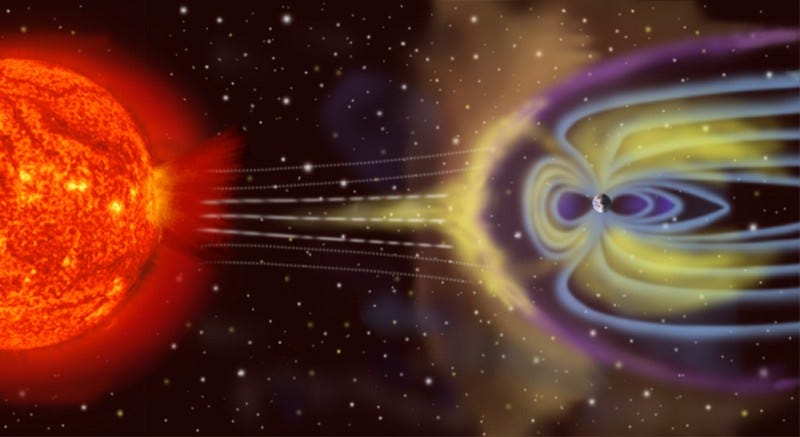Can we have Star Trek-style radiation shields on future space missions?
TeamIndus is soft-landing on the Moon in 2018, carrying with it six student-built experiments under the umbrella of Lab2Moon.
One of them is the EARS (Electrostatic Active Radiation Shield)
experiment, aiming to change the future of radiation shields for
spacecrafts and future space colonies. Seeing the potential of such an
experiment, the Shiv Nadar Foundation decided to fund the aspirational idea proposed and led by Saumil, Aniket and Aishwarya.
Earth-inspired solution to a space problem
Traditionally,
protection from space radiation for astronauts and electronics of
spacecrafts has been material-based (usually lead) a.k.a. passive
shielding. Team EARS
wants to use something that isn’t material-based, drawing inspiration
from the natural shielding that our Earth has had for billions of years.

The
magnetic field generated by the core of the Earth actively protects us
from incoming charged particles. What if we could employ just one such
active shield for every spacecraft? That is the thought that led Team
EARS to experiment with a Van de Graaff generator
to create a high electric potential difference that can deflect charged
particles. A Van de Graaff generator uses the same principle which
attracts paper pieces to a comb rubbed against your hair — static
electricity.
The setup
The
soda-can sized EARS experiment consists of a Van de Graaff generator
capable of generating a 450 kV voltage. Here is what the setup looks
like:
The
charges accumulated on the sphere-shaped conductor at the top produces a
strong electrostatic field around it. A transparent insulating
polycarbonate material around the generator and at the top complete the
structure. Two radiation sensors are placed at the top deck to monitor
incoming charged particles.
How it works
When
the conducting sphere is fully charged, the electrostatic field created
will engulf the sensors. The positively-charged sphere will attract
negative particles (like electrons) in space radiation and the sensors
will detect them. Positively-charged particles (like protons) will get
deflected due to electrostatic repulsion.
Prior
to turning on the Van de Graaff generator, both the positive and
negative charges will be picked up by the sensors. When the generator is
on and fully charged, only negative charges will be detected, thereby
decreasing the radiation count. The working of the shield will be tested
for varying levels of electrostatic potential to understand its
effectiveness.
The
entire EARS experiment is powered by electricity and a microcontroller
interfaces with the computer onboard the spacecraft. The Van de Graaff
generator will be turned on after the 14th (Earth) day of lunar landing
to avoid any possible damage to the other instruments onboard the
TeamIndus lander. The EARS sensors though will begin taking charged
radiation counts well before that day. This allows to get radiation data
starting from when the spacecraft is in Low Earth Orbit (LEO) to when
the spacecraft is on the lunar surface.
The
data will tell us about the nature of radiation on the lunar surface
and how efficient the electrostatic shielding is. If successful, this
will be the first time active radiation shielding has been demonstrated
in deep space.
The
bionic Soviet mission Kosmos 605, launched in 1973, demonstrated a
working electrostatic radiation shielding in LEO. Team EARS wants to
test the feasibility of this concept on the Moon onboard the TeamIndus spacecraft, gearing for launch in 2018.
Advantages of an active radiation shield
There are numerous advantages of an active shield over a static one.
- Active shielding is cheaper than material-based shielding for the same amount of efficiency due to reduced material cost.
- The ability of a material-based shield to protect from radiation deteriorates with time. For long space missions, a self-sustainable active shield is thus more effective and reliable.
- An active shield reduces launch cost as the significant mass of a passive shield is reduced.
One
disadvantage of an electrostatic shield is that it can’t block X-rays
or gamma rays as the shield is charge-based. There is another Lab2Moon
experiment onboard the lander which is innovating on that front. The
team Space4Life aims to replace the lead shield with a cyanobacterial one, while handling intense gamma-rays too.
Applications
The
potential applications of an active radiation shield are numerous. The
habitable modules of future lunar colonies can be protected using such a
shield. Even manned rovers being driven on the lunar surface could make
use of it. The EARS experiment, while small, will lay the groundwork to
determine the full-scale requirement of employing a radiation shield
capable of protecting future lunar colonies.
The next steps
Simulations of the EARS experiment using Strontium-90
as radiation source has yielded positive results (pun intended). The
next step is to test the experiment on the particle accelerator
“Microtron” available at the University of Pune. The conditions in the
vacuum of the accelerator closely mimic the lunar environment. After
that, Team EARS will be ready to fly to the Moon in 2018 and take their
moonshot.
Conclusion
Van
de Graaff generators saw their first application as particle
accelerators. From being the first particle accelerators to potentially
accelerating the future of space exploration and settlement, the Van de
Graaff generator has been one neat invention. Who wouldn’t like to have
Star Trek-style radiation shields? I know I would.